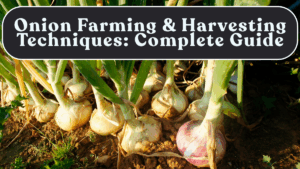The onion farming guide is a must-read for both beginners and experienced growers who want to maximize yield and quality. Onions are one of the most widely cultivated vegetables across the world, valued for their flavor and medicinal properties. Successful onion farming depends on understanding the right soil preparation, seed variety, sowing method, and fertilizer management.
Whether you’re starting a small backyard patch or planning a large-scale farm, this guide covers everything you need to know—from seed to harvest.

Ideal Climate and Soil Requirements
Onions grow best in cool, dry climates with plenty of sunlight. They need moderate temperatures of 13–24°C for vegetative growth and slightly warmer conditions for bulb formation.
Soil Type:
-
Well-drained loamy or sandy-loam soil rich in organic matter.
-
Soil pH between 6.0 and 7.0 is ideal.
-
Avoid waterlogged or clay-heavy soils, as these can cause bulb rot.
Before sowing, plow the field two to three times and add well-decomposed farmyard manure (FYM) or compost to improve soil texture and fertility.
Varieties of Onion
Some high-yield and popular onion varieties include:
-
N-53: Suitable for both rabi and kharif seasons.
-
Pusa Red: Known for bright color and good shelf life.
-
Agrifound Light Red: Best for northern Indian conditions.
-
Bhima Super / Bhima Shakti: High-yielding hybrids for commercial farms.
Choosing the right variety for your region’s climate ensures better bulb formation and disease resistance.
Sowing and Spacing
Onions can be grown by seed sowing or transplantation.
-
Nursery Method: Sow seeds in raised beds about 1 cm deep and cover lightly with soil.
-
Transplant seedlings 6–8 weeks old when they reach 15–20 cm height.
Spacing Guidelines:
-
Row spacing: 15–20 cm apart.
-
Plant spacing: 10 cm apart within rows.
Proper spacing ensures bulbs get enough sunlight and nutrients for uniform growth.
Fertilizer and Nutrient Management
Nutrient balance is critical for bulb development. Apply fertilizers as follows:
-
Basal dose: 20 tons FYM per acre before sowing.
-
Nitrogen (N): 50–60 kg/acre, split into two doses—half at sowing, half after 30 days.
-
Phosphorus (P): 30–40 kg/acre.
-
Potassium (K): 40–50 kg/acre.
Additionally, use micronutrients like zinc and boron sprays for better color and size. Avoid over-fertilization, which can cause excessive leaf growth instead of bulb development.
Irrigation and Weed Control
Onions require frequent but light irrigation—especially during bulb formation.
-
Water every 7–10 days depending on soil moisture.
-
Stop irrigation 10–15 days before harvesting to allow bulbs to harden.
For weed management:
-
Use pre-emergence herbicides or manual weeding at 20 and 40 days after transplanting.
-
Mulching helps retain soil moisture and suppress weeds naturally.
Pest and Disease Management
Common onion pests include thrips and onion maggots. Control them using neem-based sprays or safe insecticides.
Diseases like downy mildew and purple blotch can be prevented through crop rotation, proper ventilation, and fungicidal sprays (e.g., Mancozeb or Copper oxychloride). Always avoid water stagnation to reduce disease pressure.
Harvesting and Yield
Onions are ready for harvest 90–120 days after transplanting, once 70–80% of leaves bend down and bulbs are fully matured.
-
Uproot bulbs gently and dry them under shade for 10–15 days until outer skin hardens.
-
Sort and grade bulbs before storage or marketing.
Average Yield:
-
120–150 quintals per acre for irrigated crops.
-
80–100 quintals per acre for rainfed conditions.
Proper curing and storage in well-ventilated sheds extend shelf life up to 5–6 months.
Conclusion
Onion farming can be a highly profitable venture when done systematically. By following the correct sowing methods, nutrient plans, and pest management, farmers can achieve high yields with excellent quality bulbs. Sustainable practices such as organic composting and water conservation further enhance productivity and long-term soil health.
Whether for home use or commercial production, this onion farming guide gives you the foundation for successful cultivation—from soil preparation to final harvest.
FAQs
What is the ideal temperature for onion farming?
Onions grow best between 13°C and 24°C, with slightly warmer weather needed for bulb formation.
How many days does it take for onions to mature?
Most varieties take 90–120 days after transplanting to reach full maturity.
How much spacing is needed between onion plants?
Maintain 10 cm between plants and 15–20 cm between rows for optimal bulb growth.
How often should onions be watered?
Provide irrigation every 7–10 days, reducing frequency toward harvest time.
What is the average onion yield per acre?
Farmers can expect 120–150 quintals per acre under irrigated conditions with proper management.
